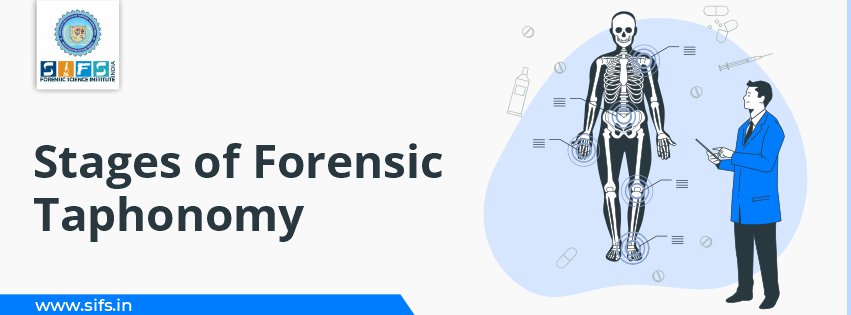- Call Us: +91 7303913002
- Email Us: education@sifs.in
Stages of Forensic Taphonomy

BY SIFS India | February 03, 2025
Stages of Forensic Taphonomy
Taphonomy is a study of what happened in-between the time of death until a body was discovered which helps to reconstruct the circumstances of the scene.
The term taphonomy is a word derived from the Greek words ‘táphos’ which means ‘burial’ and ‘nomos’ which means ‘law’ which was introduced in 1940 by soviet scientist ‘Ivan Efremov’ to study the changes of remaining organisms.
Developed within the disciplines of palaeontology archaeology and paleonarcheology.
Forensic taphonomy is a sub-field of anthropology which includes archaeology application of archaeological searches and its required sub-field techniques and its laboratory analysis in found remains and understanding the transition of bones and the soft tissues.
Forensic taphonomy frequently includes the application of disciplines in other physical science. Taphonomy is mostly focusing on environmental effects like decomposition in soil, and water and some interactions with other plants or insects or animals.
Branches of Forensic Taphonomy
There are two branches in forensic taphonomy:
Bio Taphonomy: In this bio taphonomist , study the cadavers remains to discover how the soft and hard tissues are decomposed. Like Environmental factors ( climate or animals or plants), individual factors ( age or health or body mass ) cultural factors ( autopsy processes or funeral activities ).
Geo-taphonomy: In this geotaphonomist , study how and what are the factors that affected the geological environment like how the person who buries a body affects the environment or how the body itself affects the environment. It most commonly includes soil disturbances , disruption in vegetative growth , variation in ph of the soil etc.
Stages of Taphonomy
There are five main stages in taphonomy :-
- Disarticulation: It happens when the cadaver decays and the bones are separated from the flesh and tendons of organisms.
- Dispersal: In this the separation of the parts or pieces of cadavers were caused by the natural events like flood or carnivores.
- Accumulation: In this the , under taphonomic entities the process of incorporation to lithosphere , added or formed by biogenic production which results in state of Accumulation.
- Fossilization: In this , the remains were preserved by a natural processes.
- Mechanical Alterations: This include In postmortem period , the defects in the remains.
Phases of Taphonomy
There are three phases in taphonomy :-
- Necrolysis: It refers to the decaying process of cadavers in which the soft tissues were decomposed and braked. It also includes the factors around the organisms during time of death which can also be possibly involved in cause of death.
- Biostratinomy: It is a study about the processes or changes occurred or affected a organisms such as scavengers or climate or erosion , after its death but before its final burial.
- Diagenesis: it refers to a physical or chemical or biological changes that caused on a organisms remains after its final burial. In this After decomposition, the processes , maybe physical or chemical , which affect the sedimentary elements between deposition and weathering.
Fluvial Taphonomy
Fluvial ia a term which means (of a river) something that related to or happening in a river. Fluvial Taphonomy is a study about a decomposition of a organisms in a river. An cadaver in a river may sink in the water or float in the water or it can also be carried out near the surface of water.
The decomposition process of a organisms in river is very much different than the decomposition of organisms in terrestrial.
The Fluvial environment is colder than the terrestrial environment . The ecosystem will also be different from terrestrial like The ecosystem of the living organisms which scavenge on the cadaver and the abiotic factors in rivers will also differ from terrestrial.
Limitations in Forensic Taphonomy
There are some issues which create a confusions in taphonomic analysis such as :
- The fungus over a cadaver will create the blackening of bones which may look like burned bones.
- The damage caused by sharp object may look like an carnivores tooth marks.
- The cracks created because of weathering condition may look like a crack made by a blunt force impact.
- The broken bones caused by trampling ( to walk on something ) or gnawing of carnivores which may look like a foul play ( its a activity which leads to persons death ) .
Conditions Which Make the Decomposition Process Faster or Slower than Normal
- An open injury in a cadaver will make the speed of decomposition process different because the wounds in a cadaver will provides a entry for an animal to attack.
- The decomposition process will be slow when the cadaver is kept in a freezer but it will not stop the decomposition process but when the cadaver was thaws out the process will be speed - uping rapidly.
- If a body is wrapped in a plastic for burial or disposal will also slow down the decomposition process but will hinder other disturbances like scavengers.
- There will be an impact in an decomposition process when multiple bodies were buried in same place which will also be complicated to identify remains .
The variation in the decomposes is based on some intrinsic factors like age at death or sex .
For eg : In natural ageing process we all will lose bone mass. Hence the low bone mass can also affect the decomposition process and after burial it leads to decay rapidly. Infant bones are easy to locate than adult bone.
These bones are less mineraliZed but survive very well even for 1000 years. The problem in this is it will be very small which will be difficult in excavation sometimes mistaken for animals.
Advantages of Taphonomy
Taphonomy help researchers from many fields in identifying the past events. Like from time of death and the changes in cadaver from its burial and until its discovered and also helps in identifying its past environmental changes which helps to get an clear understandings of datas and to draw conclusions.
Causal Factors of Taphonomic Damage
Rockfall, cryoturbation ( mixing of soils by thawing or freezing of ground ice ) , weathering , diabetic movement ( temperature is constant ) , mineralization of ground water , burial , volcanic Shockwave , sand blasting ( sand driven by compressed air or stream) weathering etc...
Some forces in taphonomic damage are :
Mineral absorption: - An unusual colour created on the remains can help to identify an material involved in burial including both man made and natural materials.
Weathering: It is a condition in which the natural force will alter the look bones or these weathering condition will also create a cracks in cadavers like blunt impact.
Scavengers: These can have a little to profound impact on a cadaver In which it can leave signals that can aid to identify burial location , type of animal, even the season in which the burial was deposited can be found.
Notable Forensic Taphonomists
- Alexandre lacasaange - France
- Etienne rollet - France
- Edmond locard - France
- Johann casper - Germany
Note - The figures and images used in this blog are only for educational purposes.
Written by: S . Femina

